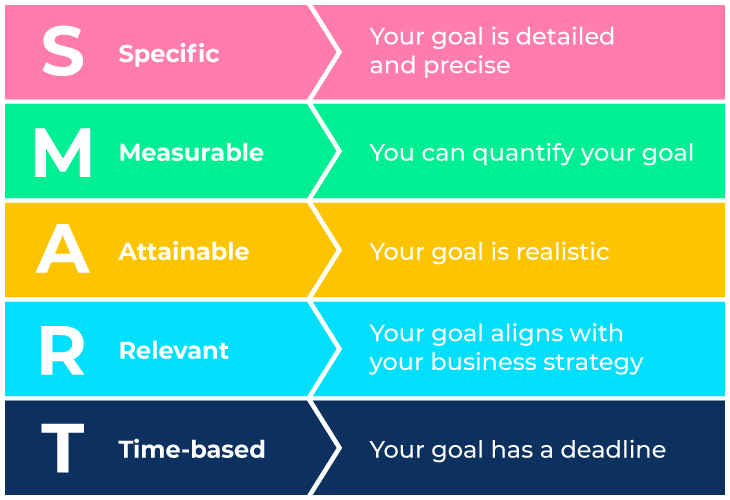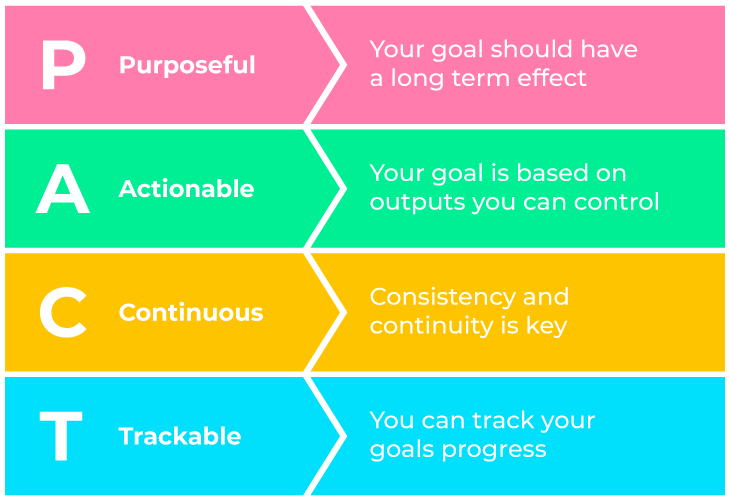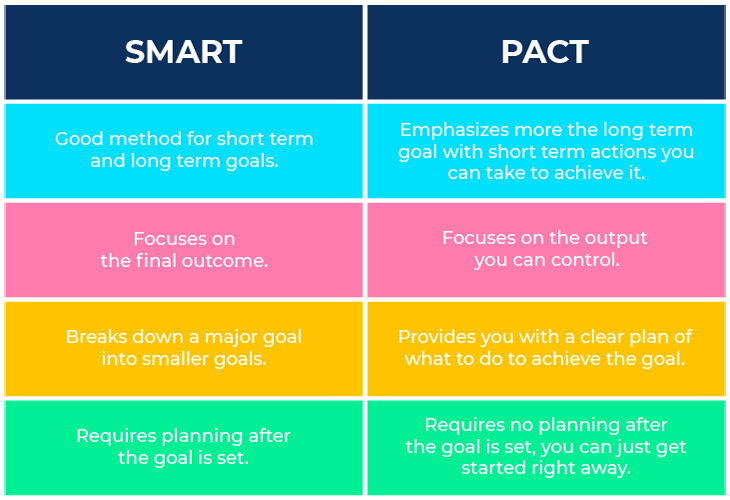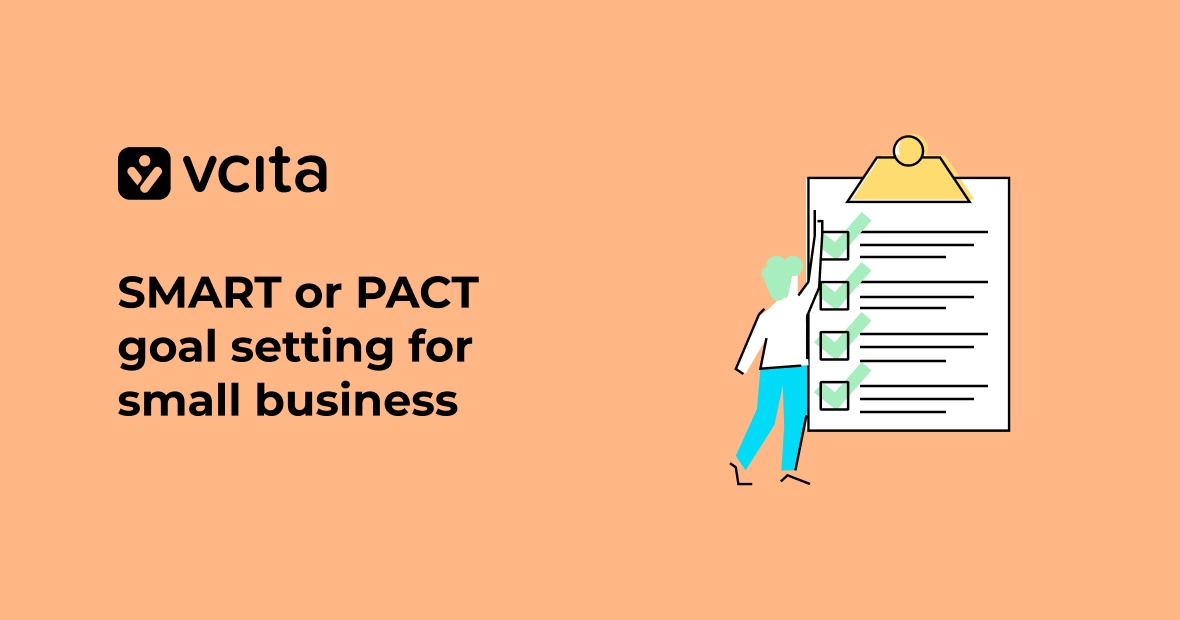Setting goals is a surefire way to build a business you’re proud of. By having clear and predefined objectives, you can better understand how to allocate resources, spend your time, budget, and plan the overall operations of your business.
There are a number of different approaches to setting goals and in this article we are going to break down two of the more popular methods: SMART and PACT. Each one comes with its own methodology and point of view, so it’s important to read through the article and decide which strategy will work best for your business.
SMART goal setting

What’s the origin of SMART goals?
The SMART goal setting approach was developed by George Doran, Arthur Miller and James Cunningham in 1981. It was first presented in an article called “There’s a S.M.A.R.T. way to write management goals and objectives”, and has since evolved into a common way executives and managers create goals for their business. Though many people believe that any goal written must follow each of the SMART acronym criteria, this is not always the case as Doran mentions in his paper.
What are SMART goals?
SMART is an acronym that determines what kinds of criteria make up a certain goal.
SMART goals should be:
- Specific: goals should be specific and answer questions like the Who, What, Where and Why.
- Measurable: each goal should have a number measure that will tell you when you have achieved it.
- Attainable: your goals should be realistic and achievable. Conduct a reality check and make sure you don’t aim too high or too low.
- Relevant: goals should align with your business values and strategy, that’s what makes them relevant.
- Time-based: make sure to specify when this goal should be achieved by and take all necessary measures to achieve the time target.
Examples of SMART goals
What makes a good SMART goal? Any goal that follows the 5 criteria and is Specific, Measurable, Attainable, Relevant, and Time-based is a SMART goal.
An example of a weak goal would be:
I want to grow my business.
Here’s how to break down that goal into a SMART one:
I want to grow my business by 50 new clients through optimizing marketing strategies and trying out 2 new social media platforms: Instagram and Twitter. I want at least 25 first appointments by the end of Q3 and 25 onboarding calls by the end of Q4.
This is a SMART goal because it fits all or most of the criteria of the SMART method. The goal is specific and measurable (50 new clients by the end of Q4), it is broken down into subgoals which makes it more attainable and there is a clear time frame for when the goal should be achieved. In general, business growth is relevant to all small businesses, so it hits that mark as well.
Now what?
You’ve started with your weaker goal and put it through the SMART process. Now what? It’s time to set up a plan to implement the goal and achieve it by the time you set yourself. A plan for the SMART goal mentioned above could include researching the two new platforms that are intended to be used, a content strategy of what to post and when, an email marketing strategy for how to turn leads into clients, and a management plan of how to organize these lists of new clients.
Once you have your roadmap, you are all set and ready to accomplish your SMART goals.
PACT goal setting

Another, more recently developed strategy for goal setting is the PACT method1. The PACT method focuses on the output rather than the outcome, which is what SMART goals focuses on. Though there isn’t much information as to the origin of this method, many are calling it a better alternative to the SMART method. We’re here to say that there is no one method that works for everybody, you have to find the most effective methodology that works for your needs.
But let’s get back into what PACT goals are.
What are PACT goals?
PACT is also an acronym for the goal setting process, and it stands for Purposeful, Actionable, Continuous, Trackable.
Here’s what all of that means:
- Purposeful: your goal should be meaningful in the long term and align with your passion, and not just be relevant to you right now.
- Actionable: your goal is based on outputs you have sway over, meaning actions you can take and control to achieve it.
- Continuous: consistent actions you can take that will help you achieve your goal
- Trackable: This is more of a “yes” or “no” approach – tracking whether or not you’ve completed the actions you needed in order to achieve your goal.
Examples of PACT goals
If we take the example above, I want to grow my business is a weak goal that needs to be structured and expanded a bit.
This is how that goal would look in a PACT way:
I am going to post on social media 3 times a week and cold email 5 new leads each day for the next 6 months until I reach 50 new clients by the end of Q4.
This goal is purposeful because it has a long lasting effect on your business, it is broken down into actionable steps that are to be repeated consistently and continuously and can ultimately be tracked. The goal focuses on the now as well as the long term.
Now What?
Unlike SMART goals, with PACT goals, you don’t have to start by setting up a plan. Your PACT goals should outline immediate actions you can take to get started on achieving your goal.
Now, as mentioned previously, the T in the PACT method is Trackable. That means that you can easily track your progress by answering “yes” or “no” to the following question: Did I do what I was supposed to do today to achieve my goal?
SMART vs. PACT goals

Think about which goal setting method works best for you and work through the steps to get yourself well on your way to achieving your biggest and smallest goals. Goal setting is a skill every small business owner should have and learning to master that skill will set you up for long term success.
1 The PACT goal setting method was created by Anne-Laure Le Cunff from Ness Labs.





